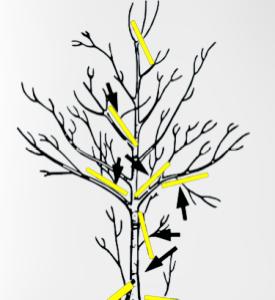We will give you information on pruning and caring for ornamental plants. We have prepared pruning techniques for ornamental plants preferred in homes or offices. The plant to be pruned should be examined together and each branch treated separately. Once the cutting points have been determined, without digging or leaving any nails, make the cut. When pruning thick branches, the cut should be done gradually. In general, the smaller the diameter of the branch being cut, the faster the wound will heal. Therefore, trees should be pruned to avoid pruning large branches when the branches are as small as possible.Score cuts should be made so that only the branch tissue is removed, the stem tissue must not be damaged. When small branches are pruned with hand tools, the cross-sectional area is clean and flat. Be careful. When you cut a branch with a saw, the branch is on the other side. should be supported. There are diseased, dry, weak and destructive branches on the plant. it should not be abandoned. The angle that the main branches make with the trunk should be 45-60 degrees, because the angle is narrow, the branches will break off quickly because the resistance is weak. In the high angled branches it is vegetative. development is weak.Pruning branches encourages vegetative growth. Without cutting or long walks, it also encourages generative action. When making the top cut, flip the eye outward and make a diagonal cut.
The Importance of Pruning Ornamental Plants
Strengthening and accelerating the development of ornamental plants, healthy development of plants. to ensure the desired shape, to ensure the quantity and quality of flowering and fruiting. Cropping is performed to increase it. Format; Plant development, strengthening, maintaining their healthy development. Used in ornamental plants to increase flowering, fruit quantity and quality. Shearing, bending, bending, picking buds and shoots, adjusting the angle of inclination of the branch relative to the trunk such operations.
In general, pruning is very important for plant growth, development and yield. has an important place. Pruning practices are primarily related to plant physiology and ecology. it should be true. In general, the goals of ornamental pruning are: You can order: To establish and maintain a physiological balance in ornamental plants in a short time. Remove branches that fall from the tree and could cause injury or property damage. withdraw. Remove branches blocking the view of the road. Dry, diseased, broken by ecological and mechanical action, noxious and obliquely overlapping, protruding from below, hanging head, asymmetrical, destabilizing the tree, branches weak and severely cut. To increase the uptake (assimilation) of carbon in plants, light is used to allow better penetration into the interior of trees and to clean the surface of leaves.Increase. Determining the number and arrangement of the main branches on the trunk to form a strong, regular and balanced crown. Make plants beautiful by giving them different shapes. preservation of plant form. To increase flower yield and plant quality.
In which seasons are ornamental plants pruned?
Trimming time for ornamental plants can vary by species. for pruning In general, plants are dormant and can grow under certain conditions. Pruning times need to be determined taking into account the size of some species. We can express the times as . The prime time for cutting hardwoods is the end of winter.

The growth of flowering species (decorative cherry, crab apple, black locust, red bud, etc.)) pruning should be done during the flowering period, i.e. at the end of spring. On species with bleeding traits (maple, walnut, birch, elm etc.) it prefers the autumn months when water pressure is low. Duty. Annual dry pruning (cutting off dry branches) of conifers can be done during the season.The green cutting (cutting of wet branches), on the other hand, should be done outside the vegetation period, i.e. in autumn or winter. In this case, wound closure is more difficult with the onset of the growing season. It’s easy, the flow of sap and resin from the wound surface is minimal. take place. In addition, fungal infections and bark beetle proliferation can be prevented. Juniper, boxwood, cypress and false cypress grow throughout the season. Cutting time can be all year round. However, these can also be cut in June, July or even in August. We prune all flowering shrubs and dwarf trees after flowering. Pruning back in early spring allows these species to bloom that year.Obstacle. On species such as summer- or autumn-flowering coniferous pruning trees, this should be done in winter or early spring before plowing. Otherwise it will open this year, the flower buds will be removed when pruned and the tree will not flower this year.

In which seasons are ornamental plants pruned?
Trimming time for ornamental plants can vary by species. for pruning In general, plants are dormant and can grow under certain conditions